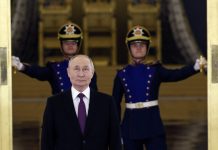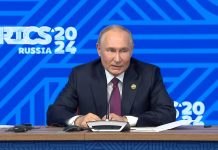The overwhelming scale and deeply destructive nature of the Kremlin’s information war has only recently drawn attention of the Western mainstream media and policymakers. In part one of his essay, prominent Russian media analyst Vasily Gatov, visiting fellow at the Center of Communication Leadership and Policy, University of Southern California, explains the origins of the Russian propaganda and Putin’s anti-Western narrative.

As consumption of mass media has increased dramatically in modern times, outscoring all other human habits in absorbing hours and minutes of life, the idea of “information weaponry” has become a kind of banality. Propaganda, framing, agenda setting, and dozens of other armaments have been recognized since 1921, when Walter Lippmann first described the mechanics of mass media influence over public opinion. He was followed by the “father of public relations,” Edward Bernays, who formulated the tools and secrets of the propaganda trade and laid the groundwork for huge tribes of later propagandists.
Winding the clock forward, we can see how propaganda and mass media helped, if not formed, the initial success of the Nazi Party in Germany. We can see how Stalin brainwashed the whole population of the largest country in the world. We can observe the total propaganda assault of Mao Zedong’s Cultural Revolution, and its cruel policy of censorship. We must acknowledge, too, that Bernays’ colleagues and followers in the propaganda profession made large contributions to these “information wars” as well.
Starting in 1917, a Soviet narrative appeared that was ideological, Marxist, and aggressive; it offered a story of the proletarian fight for freedom and equality, while redefining freedom in an Orwellian way, as a subjection of individual interests to the class’s interests. The Soviet narrative was quickly recognized as a dangerous weapon by many Western governments. During the first half of the twentieth century, the countermeasures taken against it could be disgusting and cruel. During the Red Scare the United States persecuted and deported thousands of European socialists and communists who had fled their home continent. Those who embraced the communist narrative were massacred in Spain under Franco’s regime. Every Western country persecuted leftists one way or another as they strove to fight the possible dangers of subversion. Later in the century, these countries shifted to the more advanced and “soft” weapons in their arsenal, including those designed to allow the West to infiltrate Soviet territory and affect Russia’s domestic situation (measures that were, in fact, a response to the USSR’s attempts to infiltrate and influence the Western public sphere).
In 1991, an important turning point occurred with the collapse of the USSR and the consequent dismissal of one of the major wielders of “information weaponry.” Clearly, support for the Soviet narrative had also collapsed. Meanwhile, there was (and still continues to be) a major discussion on whether the confrontation of narratives occasioned by the Cold War transformed the nature of the mass media in the West; the 1998 Herman and Chomsky treatise Manufacturing Consent offered a structured model of this mutation. The purpose of this article is not to argue with the propaganda model or reinforce its legacy, but rather to offer a different angle on the model that comes from observations of the recent changes in the current Russian narrative and its tools of war.
The New Old Narrative
1991 is so important in this context because the date symbolizes the defeat of an organized Soviet narrative. It would be totally misguided to say that communist ideas about the utopian nature of the “just” society that would overturn exploitation of the masses were only promoted by Russians. The “natural left” has always existed, and there are still many who support this ideology, but what happened in August of 1991 marks the end of the funding that was previously made available to those who supported this narrative. It is unlikely that we will ever have the chance to expose the full scale of Soviet investment in this cause, not only because those archives are still classified, but also because this investment was diverse, delivered through many channels, including the governments of the USSR’s various client-states. One thing is certain: this was a well-funded system, built around the twin aims of aggression and submission.
The West, in response, crafted its own system to counter Soviet propaganda and wage its own campaign. Unlike the USSR, where ideology was the top priority of the governing party, Western countries needed a lot of organizational engineering to get their systems up and running. It was a difficult task for them, as most governments in the West were either legally prohibited from owning mass media outlets or were very limited in their access to and control of editorial policy (which was necessary to disperse the messages and other narrative elements that would counteract the Russian effort).
To put the record straight, a revanchist part of the Russian political elite (the same elite that Putin later decided to join and lead) interpreted 1991 as the “illegitimate victory” of the West. This narrative was never mainstream in the Russian public sphere, but it has always been present there.
Yet the system was built in the West, and it played a distinctive role in the end of the USSR and the fall of the Eastern bloc. There is no doubt the Soviet Union fell victim to many factors, including self-inflicted damage. What is interesting—and, to an extent, the key to the present-day conflict in the media space—is how much the West’s counternarrative (or so-called “active measures” against the USSR) really affected the Western mass media, as well as Western education, ethics, communication, and values, and transformed it into what Chomsky portrayed as an evil factory of consent.
When Vladimir Putin first outlined the framework of a new Russian narrative in his Munich Speech in 2007, it came as a surprise to policymakers—but not to policy experts. The Russian public sphere had never let go of the 1991 defeat. The first step in understanding what happened is to look at the various interpretations of the USSR’s collapse. While the West largely agreed that the Soviet empire was destroyed by its own internal controversies, policy mistakes, and economic inefficiency, some Russians viewed the collapse as an inspired, treacherous coup d’état by the United States and their allies. In their opinion, the defeat was “illegitimate,” as the Soviet Union was not crushed militarily but collapsed as a result of a secret operation, when the converted leaders of the Communist Party of the Soviet Union (CPSU) “capitulated” and surrendered to the “world hegemon.” This is a twisted logic, but without explanation of its origin one can hardly understand Putin’s sorrow over and lament for the “tragic finale” of the USSR and the alleged humiliation of the Soviet nation that followed.
To put the record straight, a revanchist part of the Russian political elite (the same elite that Putin later decided to join and lead) interpreted 1991 as the “illegitimate victory” of the West. This group embraced a worldview centered on the idea of a U.S.-led plot that successfully established Mikhail Gorbachev as General Secretary of the CPSU; persuaded him to retreat from “the Soviet sphere of influence”; weakened Soviet military power; and eventually opened the door to a cabal of crooks who seized control, dismantled the USSR, and threw the nation into despair.
This narrative was never mainstream in the Russian public sphere, but it has always been present there. Once again, the central idea of this narrative is “illegitimate victory and consequent humiliation.” With this structure as a centerpiece, the idea then interprets every following event—whether political, military, or even cultural—as proof of the plot and the “criminal intentions” of a West that still aims to discover other means of humiliating the country.
When Russian privatization was carried out under the guidance of Harvard advisers, the promoters of this narrative immediately interpreted their presence as proof of the United States’ intention to purchase the assets of Russian companies cheaply and destroy the country’s economy. When the West neglected Russian public opinion on the Yugoslav Wars (regardless of the real reasons for that neglect), this same group saw its disregard as further reinforcement of the humiliation hypothesis. Russians perceived the Dayton agreements as an attack on the Serbs; the handling of Kosovo in the following years deepened Russian resentment of Western ignorance of some important “red lines” (supposedly drawn sometime in the 1870s and neglected ever since but revived when it became necessary to justify Russia’s presence in the Balkans). When NATO used its power to quell Serbian president Slobodan Milosevic, the promoters of the Soviet narrative used the event as an additional argument to bolster their hypothesis of the humiliation and aggression that the United States was plotting for Russia.
The abovementioned part of the Russian elite used every real (or imaginary) incident to strengthen its conspiracy theory. By the time of Putin’s Munich speech, this narrative had become sufficiently powerful to become a national narrative. The Russian president did nothing different from what other populist leaders do: he took control of and publicized this narrative under his own name.
From 2007 on, this narrative became a weapon that Putin and other members of his administration could develop and perfect. As a result, Russia Today, a Kremlin-funded television network launched in 2005, abandoned its toothless “promotion of the Russian nation” to become an instrument of “manufacturing discontent.” Rebranded as RT, it openly states its goal not as reporting the news, but as interpreting the news in order to cultivate discontent with “official Western narratives.”
Russia has taken on the practices of the CPSU that funded fellow communist parties and insurgents worldwide to fight, in the words of Vladimir Lenin, “for the values of communism and the interests of the working class.” Surprisingly, the recipients of the funding the government disperses today are not leftist parties, but ultra-nationalists and public intellectuals who have agreed to promote the government-approved message on the West’s “illegitimate victory” and quest for Russian humiliation.
By Vasily Gatov, Institute of Modern Russia





